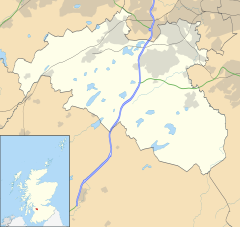Giffnock
| |
|---|---|
| Town and administrative centre | |
 Shops on Fenwick Road | |
| Population | 12,250 (2022)[3] |
| OS grid reference | NS565585 |
| • Edinburgh | 51 mi (82 km) ENE |
| • London | 344 mi (554 km) SSE |
| Lieutenancy area | |
| Country | Scotland |
| Sovereign state | United Kingdom |
| Post town | GLASGOW |
| Postcode district | G46 |
| Dialling code | 0141 |
| Police | Scotland |
| Fire | Scottish |
| Ambulance | Scottish |
| UK Parliament | |
| Scottish Parliament | |
Giffnock (/ˈɡɪfnək/; Scots: Giffnock; Scottish Gaelic: Giofnag, pronounced [ˈkʲifnak]) is a town and the administrative centre of East Renfrewshire in the Central Lowlands of Scotland.
It lies 3.7 miles (6.0 km) east of Barrhead, 5.6 miles (9.0 km) east-southeast of Paisley and 5.3 miles (8.5 km) northwest of East Kilbride, at the southwest of the Greater Glasgow conurbation.
Giffnock has frequently been named amongst the most affluent areas in Scotland. It had been first place but that title went to Stockbridge, Edinburgh in 2020.[4][5]
Giffnock is mentioned in documents as early as the seventeenth century as a scattered agricultural settlement. In the late eighteenth century, Archibald Montgomerie, the Earl of Eglinton, was forced to partition the land into a number of smaller properties.
The urbanisation and development of Giffnock began in the mid to late nineteenth century with the construction of several sandstone quarries, and this prompted the development of the first railway link with nearby Glasgow. Large-scale quarrying continued in Giffnock for almost a century. However, the quarrying ceased by the 1920s, and other uses were found for the quarries. An additional railway service began at the start of the twentieth century, closely followed by the arrival of Glasgow Corporation Tramways. Giffnock's relative closeness to Glasgow coupled with the local industry and good transports links helped it to develop into a suburban town, as many wealthy merchants chose to construct villas in its smog-free environs and commute daily to the city.
Although heavy industry died out in the area during the early twentieth century, as part of Scotland's densely populated Central Belt, Giffnock has continued to grow as a dormitory town, supported by its position within the Greater Glasgow area, from roughly 1,425 residents in the early twentieth century to 16,178 in 2001. Expansion continues due to several new housing developments; however, much of the land is now urbanised or designated parkland, leaving little room for further expansion.
- ^ Cite error: The named reference
GaelicNamewas invoked but never defined (see the help page). - ^ "List of Railway station names". Archived from the original on 22 January 2013. Retrieved 20 December 2012.
- ^ "Mid-2020 Population Estimates for Settlements and Localities in Scotland". National Records of Scotland. 31 March 2022. Retrieved 31 March 2022.
- ^ Macnab, Scott (28 January 2020). "Edinburgh's Stockbridge is the 'least deprived' area of Scotland". The Scotsman. JPI Media Publishing. Retrieved 23 April 2021.
- ^ Haugh, Jack (30 January 2020). "Barrhead's most and least deprived areas revealed". Barrhead News. Gannett. Retrieved 23 April 2021.


